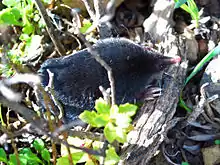Broad-footed mole
The broad-footed mole (Scapanus latimanus) is a species of mammal in the family Talpidae.[2] It is found in Baja California in Mexico and in California, Nevada and Oregon in the United States at elevations up to 3000 m above sea level.[1]
| Broad-footed mole | |
|---|---|
 | |
| Scientific classification | |
| Kingdom: | Animalia |
| Phylum: | Chordata |
| Class: | Mammalia |
| Order: | Eulipotyphla |
| Family: | Talpidae |
| Genus: | Scapanus |
| Species: | S. latimanus |
| Binomial name | |
| Scapanus latimanus (Bachman, 1842) | |
 | |
| Broad-footed mole range | |
Description
The broad-footed mole can be distinguished from other species of Scapanus by its dark brown to silvery fur, and 40-44 unevenly spaced unicuspid teeth.[3][4] Adults range from 14 to 18 cm in total length on average, with males slightly larger than females. Populations in more humid environments also tend to have larger individuals than those from southern, drier areas.[3] The dental formula of Scapanus latimanus is 3.1.4.33.1.4.3 × 2 = 44.[3]
Its karyotype has 2n = 34, FN = 64.[2] As with most moles, it requires moist, friable soils, where it eats earthworms, insects, other invertebrates and some plant matter.[5]
Scapanus latimanus is a fossorial mammal, living below ground for most of its life.[3] Only one animal occupies a burrow at a time and if a burrow has been vacated, it is often reoccupied within 2 days.[3] Tunnels are typically dug far below surface level and the excess earth is removed via shafts that run laterally and vertically up to the surface. The excess earth pushed out of these shafts form distinct volcano-shaped mounds with the older earth towards the outer base and the newer earth towards the core.[3] Shallow surface tunnels are sometimes dug and form a ridge in the soil on the surface. How often exactly these tunnels are used is unknown, as they are used irregularly.[3]
Classification
Up to 12 subspecies of S. latimanus have been recognized,[3] but a taxonomic revision published in 2004 recommended the southernmost subspecies, S. l. anthonyi (Anthony's Mexican mole) be elevated to full species, and recognized only five subspecies of S. latimanus.[4] Anthony's Mexican mole is the smallest species (or subspecies) in the genus Scapanus and differs from S. latimanus in dental and cranial characteristics.[4]
References
- Matson, J.; Woodman, N.; Castro-Arellano, I. & de Grammont, P.C. (2008). "Scapanus latimanus". IUCN Red List of Threatened Species. 2008. Retrieved 9 February 2010.CS1 maint: ref=harv (link)
- Hutterer, R. (2005). "Order Soricomorpha". In Wilson, D.E.; Reeder, D.M (eds.). Mammal Species of the World: A Taxonomic and Geographic Reference (3rd ed.). Johns Hopkins University Press. p. 302. ISBN 978-0-8018-8221-0. OCLC 62265494.
- Verts, B. J. & Leslie N. Carraway (2001). "Scapanus latimanus" (PDF). Mammalian Species. 666: 1–7. doi:10.1644/1545-1410(2001)666<0001:sl>2.0.co;2. Archived from the original (PDF) on 2016-03-03. Retrieved 2014-02-18.
- Yates, Terry L. & Jorge Salazar-Bravo (2004). "A Revision Of Scapanus latimanus, with the Revalidation of a Species Of Mexican Mole". In Sánchez-Cordero V. & Medellín R.A. (eds.). Contribuciones Mastozoológicas En Homenaje A Bernardo Villa (PDF). Instituto De Biología e Ins Tituto De Ecología, Unam, México. pp. 479–496.
- "Archived copy". Archived from the original on 2018-06-04. Retrieved 2012-08-30.CS1 maint: archived copy as title (link)
